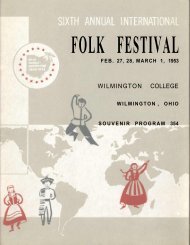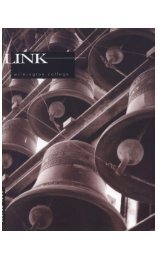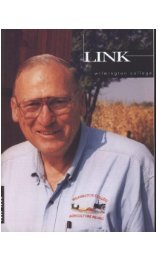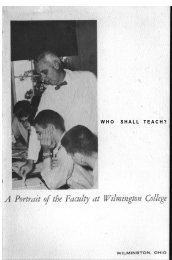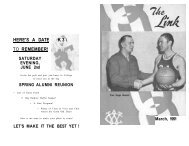Link 1995 10 (Vol. 45, No. 3).pdf - DRC Home - Wilmington College
Link 1995 10 (Vol. 45, No. 3).pdf - DRC Home - Wilmington College
Link 1995 10 (Vol. 45, No. 3).pdf - DRC Home - Wilmington College
Create successful ePaper yourself
Turn your PDF publications into a flip-book with our unique Google optimized e-Paper software.
Building Project Was PR Bonanza<br />
"We had a good story."<br />
In spite of the hoopla gained from politicians<br />
who jumped on the Marble Hall<br />
bandwagon; in spite of the public attention<br />
surrounding the praise of <strong>Wilmington</strong> <strong>College</strong><br />
by such dignitaries as Henry Ford II<br />
and former President Herbert Hoover; and<br />
in spite of public relations director Ira G.<br />
Hawk's media contacts and effective PR<br />
techniques, at the heart of the whirlwind of<br />
media coverage was a darn good story.<br />
"There was a tremendous outpouring<br />
of cooperation from students, faculty, staff<br />
and the community," said Hawk, a 1946<br />
<strong>Wilmington</strong> graduate and the director of<br />
public relations, admission and alumni during<br />
those dynamic years early in Sam<br />
Marble's administration.<br />
He said the building of Marble Hall was<br />
representative of "an exciting era of new<br />
opportunities" in the country after World<br />
War II that continued to gain momentum.<br />
"It was a new era and people were<br />
enthusiastic about it, and Sam Marble was<br />
able to challenge them," Hawk said recently<br />
from his home in Bonita Springs, Fla., where<br />
he retired after a long career with GM.<br />
Hawk recalls being privy to Marble's<br />
plan before it was unveiled at the convocation,<br />
so he contacted the local media about<br />
attending with the promise of something big<br />
in the works. They were not disappointed as,<br />
before the day was over, the president had<br />
given a rousing talk from atop the podium;<br />
students had broken ground with 150 shovels;<br />
and the construction of the new dormitory<br />
had begun with student volunteers.<br />
"It was a very dramatic beginning,"<br />
Hawk said.<br />
Before long, regional media in Cincinnati,<br />
Dayton and Columbus caught wind<br />
that something unique was happening in<br />
Clinton County. From there, the story spread<br />
across the country — and the world.<br />
"We got a number of stories on the<br />
wire, and we placed pictures on Associated<br />
Press and United Press International as well,"<br />
said Hawk, who put in hundreds of overtime<br />
hours taking photos, writing stories and<br />
facilitating international media interest.<br />
In addition to those Ohio newspapers,<br />
stories appeared in such publications as the<br />
8 Fall <strong>1995</strong><br />
New York Herald Trilune, Christian Science<br />
Monitor, San Francisco News, Washington<br />
Post, American Magazine,<br />
Newsweek, Time, Pathfinder Magazine and<br />
Look — to name a few.<br />
"When the story ultimately made the<br />
Reader's Digest, that was the capstone,"<br />
Hawk said, noting the coverage went beyond<br />
strictly news stories and included editorials<br />
lauding <strong>Wilmington</strong>'s self sufficiency<br />
and pioneer spirit.<br />
The building project was news world-wide.<br />
The New York Times described the<br />
project as something "unique and exciting<br />
in higher education."<br />
The Providence Jc urnal wrote that WC<br />
"has discovered all in cne process an excellent<br />
substitute for football, a fine antidote<br />
for mere learning, a fresh classroom technique<br />
and the irreplaceable consolation of<br />
doing work with one's hands."<br />
"It is a heartening story," wrote the<br />
Manchester (England Guardian, "an instance<br />
of the spirit whi:h makes the United<br />
States a great country :o live in."<br />
During a stretch of the construction,<br />
Radio Luxemburg was regularly broadcasting<br />
a status report by WC students throughout<br />
Europe.<br />
As the <strong>College</strong> was inundated with photographers,<br />
radio crews and news reporters,<br />
Marble was more than accommodating, as<br />
he and Hawk realized the value of the publicity,<br />
not only because it provided positive<br />
public relations opportunities and helped<br />
motivate the students to continue working,<br />
but it was helpful in attracting money and<br />
contributions of materials, which, ultimately,<br />
proved essential for completing the project.<br />
Marble was undeniably at the eye of the<br />
media hurricane. Hawk likened the aura<br />
surrounding the young president to the excitement<br />
generated by John F. Kennedy a<br />
decade later.<br />
"Here was a bright, charming energetic<br />
new president in Dr. Marble," he said, noting,<br />
at 32, he was the youngest president in<br />
the country. "He had great enthusiasm; he<br />
dared to be different; students identified<br />
with him; and he had a wife who looked like<br />
Ingrid Bergman."<br />
Newsweek said Marble — "a Ph.D. in<br />
dungarees" — looked more like a college<br />
president "than (actor) Ronald Coleman ever<br />
will."<br />
In addition to looking the part, Marble<br />
seemed to possess an endless supply of<br />
profound statements quoted by the media,<br />
some of which portray the building of Marble<br />
Hall as a microcosm for something greater:<br />
"A college education does not excuse a<br />
man (or woman) from work; it only entitles<br />
him (or her) to do it," Marble told the Columbus<br />
Sunday Dispatch Magazine.<br />
"There are so many things to be done...,<br />
and I don't know of a better place than<br />
<strong>Wilmington</strong> to help young people learn to<br />
make a contribution to community living<br />
and influence the whole education system...,<br />
yes, even the world."<br />
In describing the building project.<br />
Marble told Newsweek: "We are not primarily<br />
interested in saving money, although<br />
that, of course, is pleasant. We are trying<br />
rather to teach our students that seemingly<br />
insoluble problems — like the construction,<br />
without sufficient funds, of desperately<br />
needed campus buildings — can be solved.<br />
"In later life they will perhaps then be<br />
encouraged to tackle other seemingly insoluble<br />
problems — like world peace."<br />
— by Randy Sarvis




